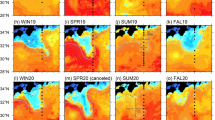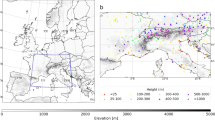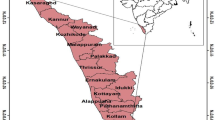Abstract
Wind and wave data are essential in climatological and engineering design applications. In this study, data from 15 buoys located throughout the South China Sea (SCS) were used to evaluate the ERA5 wind and wave data. Applicability assessment are beneficial for gaining insight into the reliability of the ERA5 data in the SCS. The bias range between the ERA5 and observed wind-speed data was −0.78–0.99 m/s. The result indicates that, while the ERA5 wind-speed data underestimation was dominate, the overestimation of such data existed as well. Additionally, the ERA5 data underestimated annual maximum wind-speed by up to 38%, with a correlation coefficient >0.87. The bias between the ERA5 and observed significant wave height (SWH) data varied from −0.24 to 0.28 m. And the ERA5 data showed positive SWH bias, which implied a general underestimation at all locations, except those in the Beibu Gulf and central-western SCS, where overestimation was observed. Under extreme conditions, annual maximum SWH in the ERA5 data was underestimated by up to 30%. The correlation coefficients between the ERA5 and observed SWH data at all locations were greater than 0.92, except in the central-western SCS (0.84). The bias between the ERA5 and observed mean wave period (MWP) data varied from −0.74 to 0.57 s. The ERA5 data showed negative MWP biases implying a general overestimation at all locations, except for B1 (the Beibu Gulf) and B7 (the northeastern SCS), where underestimation was observed. The correlation coefficient between the ERA5 and observed MWP data in the Beibu Gulf was the smallest (0.56), and those of other locations fluctuated within a narrow range from 0.82 to 0.90. The intercomparison indicates that during the analyzed time-span, the ERA5 data generally underestimated wind-speed and SWH, but overestimated MWP. Under non-extreme conditions, the ERA5 wind-speed and SWH data can be used with confidence in most regions of the SCS, except in the central-western SCS.
Similar content being viewed by others
Data Availability Statement
These data are available at Zenodo (https://doi.org/10.5281/zenodo.5816765). All the data processing were performed using MATLAB.
References
Agarwal A, Venugopal V, Harrison G P. 2013. The assessment of extreme wave analysis methods applied to potential marine energy sites using numerical model data. Renewable and Sustainable Energy Reviews, 27: 244–257, https://doi.org/10.1016/j.rser.2013.06.049.
Amiri A, Panahi R, Radfar S. 2016. Parametric study of two-body floating-point wave absorber. Journal of Marine Science and Application, 15(1): 41–49, https://doi.org/10.1007/s11804-016-1342-1.
Babanin A V. 2006. On a wave-induced turbulence and a wave-mixed upper ocean layer. Geophysical Research Letters, 33(20): L20605, https://doi.org/10.1029/2006GL027308.
Babanin A V, Ganopolski A, Phillips W R C. 2009. Wave-induced upper-ocean mixing in a climate model of intermediate complexity. Ocean Modelling, 29(3): 189–197, https://doi.org/10.1016/j.ocemod.2009.04.003.
Behzad H, Panahi R. 2017. Optimization of bottom-hinged flap-type wave energy converter for a specific wave rose. Journal of Marine Science and Application, 16(2): 159–165, https://doi.org/10.1007/s11804-017-1405-y.
Bromirski P D, Cayan D R, Flick R E. 2005. Wave spectral energy variability in the northeast Pacific. Journal of Geophysical Research: Oceans, 110(C3): C03005, https://doi.org/10.1029/2004JC002398.
Bromwich D H, Wang S H. 2008. A review of the temporal and spatial variability of Arctic and Antarctic atmospheric circulation based upon ERA-40. Dynamics of Atmospheres and Oceans, 44(3–4): 213–243, https://doi.org/10.1016/j.dynatmoce.2007.09.001.
Bruno M F, Molfetta M G, Totaro V et al. 2020. Performance assessment of ERA5 wave data in a swell dominated region. Journal of Marine Science and Engineering, 8(3): 214, https://doi.org/10.3390/jmse8030214.
Caires S, Sterl A, Bidlot J R et al. 2004. Intercomparison of different wind-wave reanalyses. Journal of Climate, 17(10): 1893–1913, https://doi.org/10.1175/1520-0442(2004)017<1893:iodwr>2.0.co;2.
Caires S, Sterl A. 2005. A new nonparametric method to correct model data: application to significant wave height from the ERA-40 re-analysis. Journal of Atmospheric and Oceanic Technology, 22(4): 443–459, https://doi.org/10.1175/jtech1707.1.
Campos R M, Soares C G. 2016. Comparison of HIPOCAS and ERA wind and wave reanalyses in the North Atlantic Ocean. Ocean Engineering, 112: 320–334, https://doi.org/10.1016/j.oceaneng.2015.12.028.
Cavaleri L, Bertotti L, Torrisi L et al. 2012. Rogue waves in crossing seas: the Louis Majesty accident. Journal of Geophysical Research: Oceans, 117(C11), https://doi.org/10.1029/2012JC007923.
Fan Y L, Ginis I, Hara T. 2009. The effect of wind-wave-current interaction on air-sea momentum fluxes and ocean response in tropical cyclones. Journal of Physical Oceanography, 39(4): 1019–1034, https://doi.org/10.1175/2008JPO4066.1.
Gemmrich J, Thomas B, Bouchard R. 2011. Observational changes and trends in northeast Pacific wave records. Geophysical Research Letters, 38(22): L22601, https://doi.org/10.1029/2011GL049518.
Gulev S K, Grigorieva V. 2004. Last century changes in ocean wind wave height from global visual wave data. Geophysical Research Letters, 31(24): L24302, https://doi.org/10.1029/2004GL021040.
Gulev S K, Grigorieva V. 2006. Variability of the winter wind waves and swell in the North Atlantic and North Pacific as revealed by the voluntary observing ship data. Journal of Climate, 19(21): 5667–5685, https://doi.org/10.1175/JCLI3936.1.
Gulev S K, Grigorieva V, Sterl A et al. 2003. Assessment of the reliability of wave observations from voluntary observing ships: insights from the validation of a global wind wave climatology based on voluntary observing ship data. Journal of Geophysical Research: Oceans, 108(C7): 3236, https://doi.org/10.1029/2002JC001437.
Hemer M A, Church J A, Hunter J R. 2010. Variability and trends in the directional wave climate of the Southern Hemisphere. International Journal of Climatology, 30(4): 475–491, https://doi.org/10.1002/joc.1900.
Hersbach H, Bell B, Berrisford P et al. 2020. The ERA5 global reanalysis. Quarterly Journal of the Royal Meteorological Society, 146(730): 1999–2049, https://doi.org/10.1002/qj.3803.
Kumar V S, Naseef T M. 2015. Performance of ERA-interim wave data in the nearshore waters around India. Journal of Atmospheric and Oceanic Technology, 32(6): 1257–1269, https://doi.org/10.1175/JTECH-D-14-00153.1.
Le Traon P Y. 2013. From satellite altimetry to Argo and operational oceanography: three revolutions in oceanography. Ocean Science, 9(5): 901–915, https://doi.org/10.5194/os-9-901-2013.
Li X, Dong S. 2016. A preliminary study on the intensity of cold wave storm surges of Laizhou Bay. Journal of Ocean University of China, 15(6): 987–995, https://doi.org/10.1007/s11802-016-3053-2.
Liu G Q, Perrie W, Hughes C. 2017. Surface wave effects on the wind-power input to mixed layer near-inertial motions. Journal of Physical Oceanography, 47(5): 1077–1093, https://doi.org/10.1175/JPO-D-16-0198.1.
Menéndez M, Méndez F J, Losada I J et al. 2008. Variability of extreme wave heights in the northeast Pacific Ocean based on buoy measurements. Geophysical Research Letters, 35(22): L22607, https://doi.org/10.1029/2008GL035394.
Ministry of Natural Resources of the People’s Republic of China. 2020. Offshore forecast areas zoning. HY/T 0292–2020. Beijing: Standards Press of China. (in Chinese)
Mirab H, Fathi R, Jahangiri V et al. 2015. Energy harvesting from sea waves with consideration of airy and JONSWAP theory and optimization of energy harvester parameters. Journal of Marine Science and Application, 14(4): 440–449, https://doi.org/10.1007/s11804-015-1327-5.
Mohapatra S. 2016. The interaction of oblique flexural gravity waves with a small bottom deformation on a porous ocean-bed: green’s function approach. Journal of Marine Science and Application, 15(2): 112–122, https://doi.org/10.1007/s11804-016-1353-y.
Monioudi I N, Velegrakis A F, Chatzipavlis A E et al. 2017. Assessment of island beach erosion due to sea level rise: the case of the Aegean archipelago (Eastern Mediterranean). Natural Hazards and Earth System Sciences, 17(3): 449–466, https://doi.org/10.5194/nhess-17-449-2017.
Niu Q R, Feng Y Q. 2021. Relationships between the typhoon-induced wind and waves in the northern South China Sea. Geophysical Research Letters, 48(8): e2020GL091665, https://doi.org/10.1029/2020GL091665.
Patra A, Min S K, Seong M G. 2020. Climate variability impacts on global extreme wave heights: seasonal assessment using satellite data and ERA5 reanalysis. Journal of Geophysical Research: Oceans, 125(12): e2020JC016754, https://doi.org/10.1029/2020JC016754.
Postacchini M, Soldini L, Lorenzoni C et al. 2017. Medium-term dynamics of a middle Adriatic barred beach. Ocean Science, 13(5): 719–734, https://doi.org/10.5194/os-13-719-2017.
Rascle N, Ardhuin F. 2013. A global wave parameter database for geophysical applications. Part 2: model validation with improved source term parameterization. Ocean Modelling, 70: 174–188, https://doi.org/10.1016/j.ocemod.2012.12.001.
Saha S, Moorthi S, Pan H L et al. 2010. The NCEP climate forecast system reanalysis. Bulletin of the American Meteorological Society, 91(8): 1015–1058, https://doi.org/10.1175/2010BAMS3001.1.
Semedo A, Sušelj K, Rutgersson A et al. 2011. A global view on the wind sea and swell climate and variability from ERA-40. Journal of Climate, 24(5): 1461–1479, https://doi.org/10.1175/2010JCLI3718.1.
Sharp E, Dodds P, Barrett M et al. 2015. Evaluating the accuracy of CFSR reanalysis hourly wind speed forecasts for the UK, using in situ measurements and geographical information. Renewable Energy, 77: 527–538, https://doi.org/10.1016/j.renene.2014.12.025.
Shi H Y, Cao X F, Li Q J et al. 2021. Evaluating the accuracy of ERA5 wave reanalysis in the water around China. Journal of Ocean University of China, 20(1): 1–9, https://doi.org/10.1007/s11802-021-4496-7.
Stefanakos C. 2021. Global wind and wave climate based on two reanalysis databases: ECMWF ERA5 and NCEP CFSR. Journal of Marine Science and Engineering, 9(9): 990, https://doi.org/10.3390/jmse9090990.
Stopa J E, Cheung K F. 2014a. Intercomparison of wind and wave data from the ECMWF reanalysis interim and the NCEP climate forecast system reanalysis. Ocean Modelling, 75: 65–83, https://doi.org/10.1016/j.ocemod.2013.12.006.
Stopa J E, Cheung K F. 2014b. Periodicity and patterns of ocean wind and wave climate. Journal of Geophysical Research: Oceans, 119(8): 5563–5584, https://doi.org/10.1002/2013JC009729.
Thomas B R, Kent E C, Swail V R et al. 2008. Trends in ship wind speeds adjusted for observation method and height. International Journal of Climatology, 28(6): 747–763, https://doi.org/10.1002/joc.1570.
Vanem E, Walker S E. 2013. Identifying trends in the ocean wave climate by time series analyses of significant wave heightdata. Ocean Engineering, 61: 148–160, https://doi.org/10.1016/j.oceaneng.2012.12.042.
Wan Y, Fan C Q, Dai Y S et al. 2018. Assessment of the joint development potential of wave and wind energy in the South China Sea. Energies, 11(2): 398, https://doi.org/10.3390/en11020398.
Wang X L, Swail V R. 2006. Climate change signal and uncertainty in projections of ocean wave heights. Climate Dynamics, 26(2): 109–126, https://doi.org/10.1007/s00382-005-0080-x.
Yan Z D, Liang B C, Wu G X et al. 2020. Ultra-long return level estimation of extreme wind speed based on the deductive method. Ocean Engineering, 197: 106900, https://doi.org/10.1016/j.oceaneng.2019.106900.
Young I R, Zieger S, Babanin A V. 2011. Global trends in wind speed and wave height. Science, 332(6028): 451–455, https://doi.org/10.1126/science.1197219.
Zhai F G, Wu W F, Gu Y Z et al. 2021. Dynamics of the seasonal wave height variability in the South China Sea. International Journal of Climatology, 41(2): 934–951, https://doi.org/10.1002/joc.6707.
Zheng C W, Li C Y. 2017. Propagation characteristic and intraseasonal oscillation of the swell energy of the Indian Ocean. Applied Energy, 197: 342–353, https://doi.org/10.1016/j.apenergy.2017.04.052.
Zheng C W, Pan J, Li J X. 2013. Assessing the China Sea wind energy and wave energy resources from 1988 to 2009. Ocean Engineering, 65: 39–48, https://doi.org/10.1016/j.oceaneng.2013.03.006.
Zheng C W, Wu G X, Chen X et al. 2019. CMIP5-based wave energy projection: case studies of the South China Sea and the East China Sea. IEEE Access, 7: 82753–82763, https://doi.org/10.1109/ACCESS.2019.2924197.
Acknowledgment
We thank the European Centre for Medium-Range Weather Forecasts for providing the valuable data used in this study.
Author information
Authors and Affiliations
Corresponding author
Additional information
Supported by the Southern Marine Science and Engineering Guangdong Laboratory (Zhuhai) (No. SML2021SP102), the Key Laboratory of Marine Environmental Survey Technology and Application, Ministry of Natural Resources (Nos. MESTA-2020-C003, MESTA-2020-C004), the Key Research and Development Project of Guangdong Province (No. 2020B1111020003), and the Science and Technology Research Project of Jiangxi Provincial Department of Education (No. GJJ200330)
Rights and permissions
About this article
Cite this article
Zhai, R., Huang, C., Yang, W. et al. Applicability evaluation of ERA5 wind and wave reanalysis data in the South China Sea. J. Ocean. Limnol. 41, 495–517 (2023). https://doi.org/10.1007/s00343-022-2047-8
Received:
Accepted:
Published:
Issue Date:
DOI: https://doi.org/10.1007/s00343-022-2047-8




